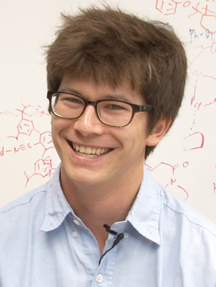The ‘Startup’ Lab: A Profile of Keary Engle
By Madeline McCurry-Schmidt
This is what it looks like when a chemistry lab is born: Boxes cover the floor. There’s a whiteboard list of things to pick up at Ikea. The lab coats are still clean…ish.
“I describe the atmosphere in the lab as like that of a startup company,” said Keary Engle, assistant professor in the Department of Chemistry at The Scripps Research Institute (TSRI). “We’re all in—and all focused on getting the lab up and running.”
Engle only recently joined the TSRI faculty, but he knows the halls of the institute’s buildings well. Engle received his PhD from TSRI in 2013. The graduate program gave him the opportunity to train with renowned chemists Jin-Quan Yu at TSRI and Véronique Gouverneur and John M. Brown at the University of Oxford as part of the unique Skaggs-Oxford Scholarship program
Today, Engle and his lab members are taking on challenges in the field of synthetic methodology. They’re looking for faster, more environmentally sustainable ways to create important drug compounds.
“We work on core technology that could be applied to the treatment of all types of disease,” said Engle.
The Challenges Ahead
Most drugs today are small molecules created with synthetic chemistry. Chemists build these small molecules in the lab using chemical reactions and tweak them to take on disease-fighting properties.
The problem is that many of the chemical reactions used to design and build small molecules rely on rare, precious metals and petroleum-based materials.
Engle is one of the growing number of “green” chemists aiming to change that. “We need to use abundant metals and renewable resources, like soybean oil,” he explained.
That means he’ll have to design and experiment with new types of chemical reactions.
At the same time, Engle’s lab is tackling another big challenge: making the practice of chemistry more efficient. Chemists can create huge libraries of small molecules through synthetic chemistry, but the process is “cumbersome,” Engle said.
He aims to streamline the process so scientists can create any small molecule in just a couple days, dramatically speeding up drug discovery and testing. Already his research has led to new insights into working with olefins, functional groups that are useful building blocks in drug design.
Back to the Beginning
Engle’s work takes chemistry back to the beginning—he’s rethinking the fundamental tools used in the laboratory. This line of inquiry has roots in his first chemistry classes at West Ottawa High School, during his teenage years back in Holland, Michigan.
He’s quick to credit his high school chemistry teacher, Gus Lukow, for getting him into the field.
“He took the material beyond what would typically be found in a high school chemistry class,” said Engle. “I saw that chemistry was a field where exploration was encouraged, and there were problems to be solved even at the most basic level.”
After graduating from the University of Michigan, Ann Arbor with a B.S. in Chemistry, Economics, Mathematics and Statistics—and spending a year as a Fulbright Fellow in Germany—Engle applied to the TSRI and University of Oxford joint doctoral program, made possible through the Skaggs-Oxford Scholarship Program.
When the joint program began in 2003, it was the first time in its 800-year history that Oxford had offered a degree jointly with another institution of higher learning. Engle started in the program in 2008 and spent roughly half his time at each institution.
“I thought it was such a unique opportunity,” said Engle. “I was able to learn from the cultures of both places.”
While TSRI focuses on chemistry and biology, Oxford offers many degrees, and Engle said it wasn’t uncommon to share the dinner table with a political philosopher or a scholar in ancient Greek.
“It’s the place where Lewis Carroll wrote Alice in Wonderland,” he said. “It has this deep, dreamy feel to it. You really get an appreciation for the whole breadth of human knowledge.”
In his time at TSRI, Engle worked with Yu, a leader in synthetic organic chemistry who has pioneered new ways to break chemical bonds and create small molecules.
“Keary helped establish the concept of using a simple amino acid ligand to accelerate an important class of C–H activation reactions that are useful for drug discovery,” said Yu.
Yu described his former student: “He is a creative thinker and an extremely broad reader. He is fully dedicated to science and education.”
The Spirit of TSRI
After completing postdoctoral work at the California Institute of Technology (Caltech) with Nobel laureate Robert H. Grubbs, Engle got to the nerve-wracking part: applying for jobs. Engle knew he’d love to come back and lead a lab at TSRI.
“I was just elated when I got an offer from TSRI,” he said. “There’s a sense of excitement and thrill of discovery that really permeates the whole place.”
And the faculty at TSRI are doing their part to welcome Engle back to TSRI in his new role.
“Everyday people are stopping by my office, seeing how things are going, seeing if I need anything,” said Engle.
He remembers the Friday night when TSRI Professor and Nobel laureate K. Barry Sharpless stopped by to chat. “I think that’s characteristic of the spirit of the place, where everyone’s in it together. There are no walls.”
Send comments to: press[at]scripps.edu















